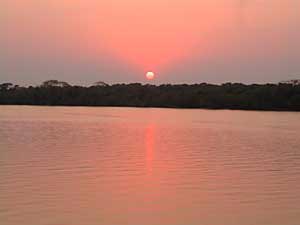|
Mangrove in India is world famous for its rich variety of flora and fauna and also for its huge area. The word `Mangrove` is considered to be a combination of the Portuguese word `Mangue` and the English word `grove`. The word is broadly used to refer to the habitat and entire plant assemblage or mangal, for which the terms mangrove swamp and mangrove forest are also used. Apart from that, Mangrove is also used to refer to all trees and large shrubs in the mangal. It is narrowly used to refer to the mangrove family of plants, the Rhizophoraceae, or even more specifically just to mangrove trees of the genus Rhizophora, as well. The Mangroves are actually salt-tolerant plants of tropical and subtropical intertidal regions and they are mainly found in the Godavari-Krishna and Sunderbans regions in India. In the regions where these plants grows are termed as `mangrove ecosystem`. These plants are extremely sensitive and fragile.
The Mangrove in India is home to numerous species of flora and fauna and the presence of Mangrove ecosystems on coastline can save lives and property during natural hazards like cyclones, storm surges and erosion, as well. They are also valuable economically. The Mangrove in India is breeding, feeding and providing nursery grounds for many estuarine and marine organisms. The ecosystem has quite a large potential for natural products that can be used for medicinal purposes and also for salt production, apiculture, fuel and fodder, etc. The Sundarbans comprise the principal portion of Mangrove in India. The Sundarban mangroves occupy a huge area followed by the Andaman-Nicobar Islands and Gulf of Kachchh in Gujarat. Compared to the Sunderbans, the rest of the mangrove ecosystems are comparatively smaller. The Mangrove in India is home to a large number of over 1600 plant and 3700 animal species.
Mangrove in India is found in tropical and sub-tropical tidal areas, and in the areas that have a high degree of salinity. The estuaries and marine shorelines are the main areas where mangals occur. Mangrove is actually a plant and the mangal is a plant community and habitat in which mangroves thrive. Though there are diverse plants in mangals and all of them are able to exploit their habitat (the intertidal zone) by developing physiological adaptations to overcome the problems of anoxia, high salinity and frequent tidal inundation. There are about 110 species identified so far, as belonging to the mangal and each species has its own capabilities and solutions to these problems. However, small environmental variations within a mangal may lead to greatly differing methods of coping with the environment.
Once established, the roots of mangrove plants provide a habitat for oysters and help to impede water flow, and by doing so, mangrove enhances the deposition of sediment in areas where it is already occurring. The fine, anoxic sediments under mangroves usually act as sinks for a variety of heavy (trace) metals that are scavenged from the overlying seawater by colloidal particles in the sediments. Mangrove in India protects the coast from erosion, surge storms (especially during hurricanes), and tsunamis and their massive root system is efficient in breaking up the wave energy. Similarly, the mangroves also slow down tidal water enough so that its sediment is deposited as the tide comes in and is not re-suspended when the tide leaves, except for fine particles. By doing so, the mangroves build their own environment. This uniqueness of the mangrove ecosystems and their protection against erosion often makes Mangrove in India, the object of conservation programs including national Biodiversity Action Plans. It has been found several times that the wave energy is typically low in the areas where mangroves grow. The Mangrove in India also supports ecosystems, adapt low oxygen, limits salt intake and water loss, and also increase survival of offspring.
 Mangrove in India includes numerous species that helps maintaining the balance of ecosystem in India. The most notable species of Mangrove in India include the major components like Acanthaceae, Avicenniaceae or Verbenaceae (Black mangrove), Combretaceae (Buttonwood, White mangrove), Arecaceae (Mangrove palm), Rhizophoraceae (Red mangrove), Lythraceae (Mangrove apple) etc. families. The families considered as the minor components of Mangrove in India include the Acanthaceae, Bombacaceae, Cyperaceae, Euphorbiaceae, Lecythidaceae, Lythraceae, Meliaceae, Myrsinaceae, Myrtaceae, Pellicieraceae, Plumbaginaceae, Pteridaceae, Rubiaceae, Sterculiaceae, etc. Mangrove in India includes numerous species that helps maintaining the balance of ecosystem in India. The most notable species of Mangrove in India include the major components like Acanthaceae, Avicenniaceae or Verbenaceae (Black mangrove), Combretaceae (Buttonwood, White mangrove), Arecaceae (Mangrove palm), Rhizophoraceae (Red mangrove), Lythraceae (Mangrove apple) etc. families. The families considered as the minor components of Mangrove in India include the Acanthaceae, Bombacaceae, Cyperaceae, Euphorbiaceae, Lecythidaceae, Lythraceae, Meliaceae, Myrsinaceae, Myrtaceae, Pellicieraceae, Plumbaginaceae, Pteridaceae, Rubiaceae, Sterculiaceae, etc.
There are several places where Mangrove in India is found including the Godavari-Krishna and Sundarbans. Mangrove occurs on islands in the Indian Ocean, Arabian Sea, Bay of Bengal, in India and the Sundarbans is considered as the largest mangrove forest in the world. Sunderbans is located in the Ganges delta in the state of West Bengal, India. Apart from that, major mangals can also be found in the Andaman and Nicobar Islands and the Gulf of Kutch in Gujarat. Some of the other significant mangals found in India, include the Bhitarkanika Mangroves and Godavari-Krishna mangroves. The second largest mangrove forest in the world, the Pichavaram Mangrove Forest is situated near Chidambaram in South India and it is home to a large variety of birds. The birds include the local resident, migratory resident and the pure migratory birds and the forest is separated from the Bay of Bengal by a lovely beach. It is also one of those rare mangrove forests, which has actually increased by 90% between the years of 1986 and 2002.
|


 |
| Mangrove in India includes numerous species that helps maintaining the balance of ecosystem in India. The most notable species of Mangrove in India include the major components like Acanthaceae, Avicenniaceae or Verbenaceae (Black mangrove), Combretaceae (Buttonwood, White mangrove), Arecaceae (Mangrove palm), Rhizophoraceae (Red mangrove), Lythraceae (Mangrove apple) etc. families. The families considered as the minor components of Mangrove in India include the Acanthaceae, Bombacaceae, Cyperaceae, Euphorbiaceae, Lecythidaceae, Lythraceae, Meliaceae, Myrsinaceae, Myrtaceae, Pellicieraceae, Plumbaginaceae, Pteridaceae, Rubiaceae, Sterculiaceae, etc.
Mangrove in India includes numerous species that helps maintaining the balance of ecosystem in India. The most notable species of Mangrove in India include the major components like Acanthaceae, Avicenniaceae or Verbenaceae (Black mangrove), Combretaceae (Buttonwood, White mangrove), Arecaceae (Mangrove palm), Rhizophoraceae (Red mangrove), Lythraceae (Mangrove apple) etc. families. The families considered as the minor components of Mangrove in India include the Acanthaceae, Bombacaceae, Cyperaceae, Euphorbiaceae, Lecythidaceae, Lythraceae, Meliaceae, Myrsinaceae, Myrtaceae, Pellicieraceae, Plumbaginaceae, Pteridaceae, Rubiaceae, Sterculiaceae, etc.